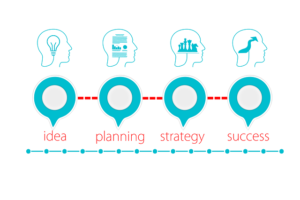Content Marketing: The 40-25-35 Formula for Effective Writing
Even though there are big rewards from content marketing for new business, it is also a huge challenge.
Content marketing is proving to be beneficial for gaining a positioning of expertise and thought leadership. It also is the magnet for generating leads and creating new business opportunities without having to pitch for them. It can also improve current client perceptions and aid in client retention.
Writing is a process that takes time and effort. Even the best writers have difficulty putting their ideas into words. They aren’t born with this gift, they have to work at it.
According to a study conducted by McLuhan and Davies, a Toronto based consulting firm specializing in communications training, effective writers spend:
- 40% of their time planning
- 25% of their time writing
- 35% of their time revising
Less effective writers usually spend:
- 20% planning
- 60% writing
- 20% revising
Here is an easy to follow formula that will help fuel your writing:
1. Plan and Organize Your Writing (40%)
 First and foremost, identify your target audience. Know who your writing to and always keep them top of mind. Write from their perspective.
First and foremost, identify your target audience. Know who your writing to and always keep them top of mind. Write from their perspective.- Reading will fuel your writing. Spend time locating resources that will provide the information and inspiration for your articles. As I’ve said many times before, use an RSS Reader such as Google Reader to stream your writing resources into one location. It is a huge time saver.
- Good content will require planning and organizing. Spend some time thinking before you start writing.
- Understanding the purpose of your writing is crucial to clearly convey your thoughts.
- Zero in on a Topic. Once you have your topic, try to narrow it down. I will ask myself questions to help narrow my topic down such as “is this a description? the characteristics of? the requirements for? the advantages in? the essentials of?”
- Next you will need to gather information on your chosen topic. You never are wasting time as you are gathering this support information. The more support information you can gather, the more effective your initial draft will be.
- Start to organize the information you’ve collected to clearly highlight your message.
2. Writing the Initial Draft (25%)
- Writing for online is different from writing for print. The attention span is much shorter. That’s why I prefer using the inverted pyramid method of writing. Most of the important information is near the top of each post article and I usually lead with the conclusion. I call it the benefit statement. I ask myself the question,“what is the reader’s primary benefit if they commit to read this article?” Then I answer the question in a single sentence and use it as a subtitle.
- I’ve learned the hard way to just start writing. I’ve wasted hours staring at a blank slate. It’s far easier if I’ll force myself to begin putting my thoughts down on paper. The following process helps me to get off to a good start each time:
- I’ll begin by creating the title which will serve as a guide and subtitle.
- I’ll then outline my post usually around 3 subheads, which helps the content to flow. This subhead also provides readers with the essence of my article if they quickly scan the piece.
- Once I have my title, subtitle and outline, I’m ready to fill in my outline. I’ve found that the quickest way to flesh out the rest of the post is towrite fast. This isn’t a time for editing or sweating out every word.
- I write the introductory paragraph and then will fill in the details under the subheads and draw from information that I’ve collected and organized in advance.
- The last step in creating the post, I’ll create a brief conclusion and some kind of call to action.
3. Editing, Revising and Polishing (35%)
Revising and editing your article are the next steps that will turn it into a document which is appealing to your readers.
Remember, 75% of your time is in the preparation and editing process and only 25% of time is spend writing the initial content. Inefficient writers spend less time planning and more time writing but then they have hardly any time to edit, revise and polish their work.
David Ogilvy, one of the most famous names in advertising, said, “I am a lousy copywriter, but I am a good editor.”
I’m my own worst editor so I usually have someone review and edit my initial draft. It is good to have some fresh eyes to review it to make sure that I’m conveying my thoughts clearly and the article makes sense. I’ll then make revisions from the edits, re-write sections and move copy around as needed. I’ll keep re-reading and tweaking until the article is ready to publish.

4. Before You Hit the Publish Button
Here are a few more elements that I add to each post before publication.
- I’ll find an image to compliment my post. The tool that I’m currently favoring isPhotoPin. This is a free service for bloggers and creatives. You can search millions of Creative Commons photos as easily as you would in Google images. It is easy to download and the service provides all of the photo credit information that you simply copy and paste into your post.
- I often add a question at the end of my posts that help enlist reader’s comments and allows me to engage with them.
- I also add a call-to-action at the bottom of each post such as “Here are some additional articles that may be of interest.” By doing work on behalf of my readers it will enhance their experience on my site and keep them on the page for longer periods of time.
- I format my post for scan-ability. Online readers usually wont commit to read a post word for word. They tend to scan. So I make my post scannable to the eye. I use headings, bold, italics, indention, block quotes, bullet or numbered lists to help content stand out. A reader can usually scan my post and get the gist of its contents.
- My new posts automatically publish to my Twitter, Facebook and LinkedIn accounts. I currently manually add them to Google +.
To be an effective writer, you should spend more time planning and less time writing. This will help create appealing content for new business.
If you have some additional writing tips, please add them to the comment section below.
About Michael Gass
Consultant | Trainer | Author | Speaker
Since 2007, he has been pioneering the use of social media, inbound and content marketing strategies specifically for agency new business.
He is the founder of Fuel Lines Business Development, LLC, a firm which provides business development training and consulting services to advertising, digital, media and PR agencies.
About the author: Michael Gass

Michael Gass, is an international new business consultant to advertising, digital, media and PR agencies. He has pioneered the use of social media, inbound and content marketing strategies specifically for agency new business.
Since the start of his consultancy in 2007, Michael has refined and sharpened his approach to find, attract and engage prospects online. He has worked with over 200 agencies in all 50 states here in the U.S. and with agencies in over 14 foreign countries.
Along with providing consulting services for individual agencies, Michael also speaks at events and conducts training for agency groups such as the 4A’s, Mirren New Business, TAAN, The Magnet Global Network, MCAN, DMA and the American Advertising Federation.



